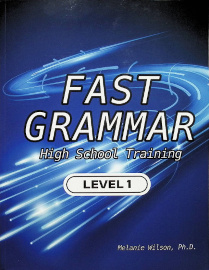High school students with little background in English grammar and those who only need a refresher can benefit from the two Fast Grammar courses. Students can use either Fast Grammar Level 1 or Fast Grammar Level 2 for partial credit for English language arts. (They still need other coursework for literature and composition.)
The courses teach parts of speech, punctuation, usage, and sentence structure, but not sentence diagramming.
Lessons are written directly to students as “missions” to accomplish for a client. Missions are grouped within weekly “operations” of four missions. That means students typically complete one lesson/mission on four days per week. However, students are welcome to complete more than one mission per day, and some will take so little time that it makes sense to do so.
Each operation begins with a Fast Facts section that presents information with rules and examples. Students learn or review the Fast Facts and write their own examples as directed in the spaces provided. When finished, they are to check their work against the samples on the next page and write more examples as directed.
With that review accomplished, students work on exercises couched as interactions with a client. The four missions per operation follow the same format as described in these “mission instructions” near the front of each book:
“In your first mission, you will receive a text update from your client. Knowledge of your clients’ intentions will allow you to make accurate corrections.
In the second mission, you will receive a graphic to help you remember the difference between common homophones (words that sound the same but have different meanings or spellings).
In the third mission, you’ll be asked to use what you’ve learned up to that point in your training to review the client’s writing. For an extra challenge, try to complete your review under the given time.
In the fourth mission, we’ll ask you to correspond with your client and practice what you’ve learned.”
Some of these interactions look like traditional grammar workbook exercises, but the client interactions provide context that ties some of them together, making them more interesting because the content itself makes sense. Students are to highlight errors and write answers directly in the workbooks. Answer keys for the missions are at the back of each book.
Both courses have the same organization, with 32 operations divided into four units. The unit titles are the same in both courses, but with more difficult concepts taught in Fast Grammar 2. Unit 1 covers parts of speech. Unit 2 teaches parts of a sentence. Unit 3 is about advanced parts of speech and agreement. Unit 4 teaches advanced grammar and writing, such as run-on sentences and parallel structures.
Lengthy unit tests and their answer keys can be requested for free through the publisher’s website. In addition, links to additional worksheets that correlate with each lesson (found at sites like EnglishforEveryone.org and Englishlinx.com) are available on the publisher’s website.
Summary
The Fast Grammar courses can bring students up to speed on their grammar skills efficiently, with a strong focus on practical usage.









